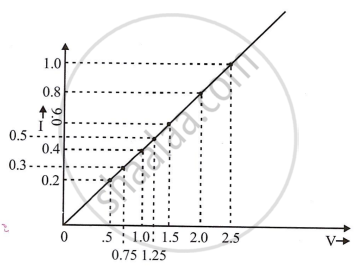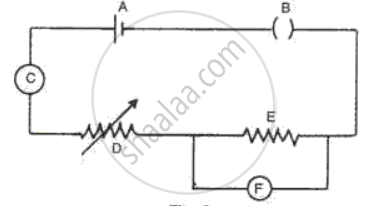Advertisements
Advertisements
प्रश्न
In an experiment of verification of Ohm’s law following observations are obtained.
|
Potential difference V (in volt) |
0.5 | 1.0 | 1.5 | 2.0 | 2.5 |
| current I (in ampere) | 0.2 | 0.4 | 0.6 | 0.8 | 1.0 |
Draw a V-I graph and use this graph to find:
- the potential difference V when the current I is 0.5 A,
- the current I when the potential difference V is 0.75 V,
- the resistance in a circuit.
उत्तर

- 1.25 V
- 0.3 A
- The graph is linear, so resistance can be found from any value of the given table. For instance:
When V = 2.5 Volt
Current is I = 1.0 amp
According to ohm's law :
R = `"V"/"I"`
R = `2.5/1.0`
R = 2.5 Ω
APPEARS IN
संबंधित प्रश्न
Will current flow more easily through a thick wire or a thin wire of the same material, when connected to the same source? Why?
Why are coils of electric toasters and electric irons made of an alloy rather than a pure metal?
Find the expression for the resistivity of a material and state the SI unit of resistivity.
What is the necessary condition for a conductor to obey Ohm’s law?
- Draw a V-I graph for a conductor obeying Ohm’s law.
- What does the slope of V–I graph for a conductor represent?
A metal sphere is kept on an insulting stands. A negatively charged rod is brought near it, then the sphere is earthed as shown. On removing the earthing, and taking the negatively charged rod away, what will be the nature of charge on the sphere? Give reason for your answer.

Fig. represents the circuit used for the verification of Ohm's law. Label the parts from A to F. state the function of each.

Rewrite the following statement by selecting the correct option.
The S.I. unit of resistance is __________.
State macroscopic form of Ohm’s law.
Suppose there is a circuit consisting of only resistances and batteries and we have to double (or increase it to n-times) all voltages and all resistances. Show that currents are unaltered. Do this for circuit of Example 3.7 in the NCERT Text Book for Class XII.
